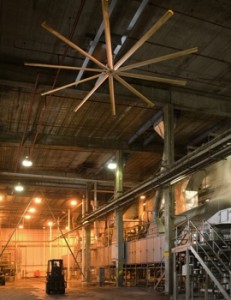
Connecting air circulation and cost savings
Food in Canada
Business Operations Facilities Maintenance energy efficiencyLarge-diameter, low-speed fans can improve plant energy efficiency, product consistency and comfort for food and beverage manufacturers

Many food manufacturers dread the costs of keeping their workforce comfortable and product temperatures consistent in spacious workplaces every winter. In other spaces, cold storage condensation can cause product loss and safety concerns. It may seem counterintuitive, but for many facilities the answer to both these issues is most known for its summer cooling abilities: ceiling fans. More specifically, large-diameter,  low-speed overhead fans can save facilities a surprising amount on their winter heating bills, with food manufacturers reporting savings of 35 per cent. The air movement from fans also clears condensation and accompanying safety and product integrity problems.
low-speed overhead fans can save facilities a surprising amount on their winter heating bills, with food manufacturers reporting savings of 35 per cent. The air movement from fans also clears condensation and accompanying safety and product integrity problems.
“In large spaces, HVAC systems are generally not capable of efficiently distributing air to all occupants,” explains Christian Taber, senior applications engineer and ASHRAE High-Performance Building Professional for Lexington, Ky.-based Big Ass Fans. “Large circulator fans mix the air in the space, ensuring good air distribution and creating uniform temperatures that increase occupant comfort and minimize stratification.”
Unlike smaller ceiling fans that struggle to send air to the floor and only create insignificant small portions of air movement, large-diameter, low-speed fans gently mix air to stabilize air movement without creating a draft in winter, using patented airfoils and winglets to allow the fan to operate in the forward direction without causing a draft.
Stratification situation
In the winter, stratification occurs because hot air is approximately five to seven per cent lighter than cool air in a space and tends to rise to the ceiling. Large-diameter fans can be used to destratify this heat by moving large volumes of warm air downward, away from the ceiling, without creating a draft. The continuous mixing of air creates a uniform temperature throughout the space, which can help the heater to maintain the same thermostat set point in a space but with less effort. The result is a serious reduction in operating costs.
A major focus for estimating winter energy savings is the difference in air temperature between the floor level and the underside of the roof, as well as taking into consideration outdoor air temperatures, with the assumption that after thermal destratification the air temperature will be essentially uniform within the space. An estimate of energy savings would consider the building envelope and the difference between heat lost through the roof and the two temperature differences before and after destratification, among other factors.
Condensation conundrum
It’s easy to assume cold storage is elementary – seal and insulate the walls, install a heavy door and turn the thermostat low. However, there is much more involved in maintaining a well-chilled storage facility. Sometimes even the most carefully designed facilities can encounter problems including dead spots and ice buildup. Introducing air movement has proven to be an effective way to curtail these issues and provide a more uniform cold storage environment.
Condensation was a big problem at McCain Foods’ production plant in Carberry, Man. Drops of water forming frozen stalactites had the potential to contaminate product, leading the Canadian Food Inspection Agency (CFIA) to voice concern about ice buildup.
“We have different air pressures in the factory. In the process area you have very moist air that is at higher pressure than the air in the freezer. What happens is that moist air comes down through the freezing tunnels and out the conveyor holes in the wall and infiltrates the freezer,” explains chief engineer Geoffrey Aitchison.
A 24-ft. diameter Big Ass Fan proved to be a simple solution. “After two weeks the ceiling was completely clear and it has been ever since,” says Aitchison. “The air is circulating, plus we’re warming the ceiling to the same temperature as the air, so the frost isn’t going to stay there.”
 With great success in its freezer, McCain Foods added another 24-ft. fan to its processing area, where condensation was forming on the ceiling above a processing tank and constantly growing mould. Just like in the freezer, the tremendous air circulation abilities of the fan kept the ceiling and air temperature consistent, preventing the moisture buildup that allows mould to form.
With great success in its freezer, McCain Foods added another 24-ft. fan to its processing area, where condensation was forming on the ceiling above a processing tank and constantly growing mould. Just like in the freezer, the tremendous air circulation abilities of the fan kept the ceiling and air temperature consistent, preventing the moisture buildup that allows mould to form.
Along with reducing condensation and creating consistent temperatures, Big Ass Fans also aids McCain Foods’ energy efficiency plans. Since the installation of their first fans in 2007, McCain Foods Canada has installed additional fans in other locations. “Our Big Ass Fans are a tremendous solution to the problem we had concerning energy conservation and satisfying the CFIA requirements,” says Aitchison.
The bottom line
By recirculating heat and reducing condensation, large-diameter, low-speed Big Ass Fans have an established track record of improving comfort and energy efficiency in Canadian food manufacturing facilities.
Print this page